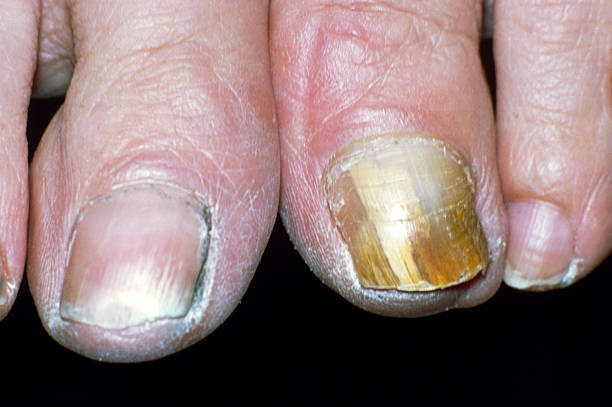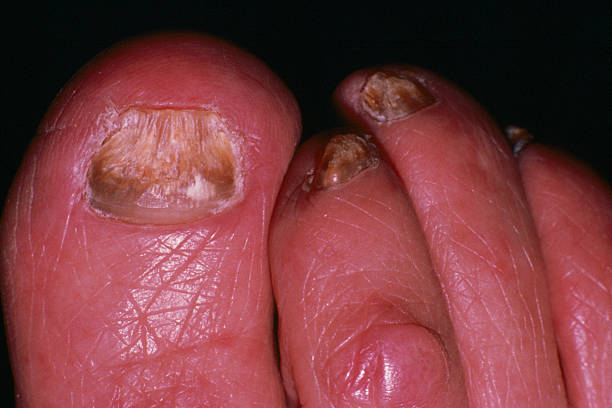Onychomycosis, also referred to as nail fungus, is a prevalent condition that affects thousands of people globally. Despite widely held opinions, nail fungus rarely has the capacity to spread. The contagiousness of nail fungus, how it spreads, and ways to avoid it will be the primary topics of this essay.
Is nail fungus contagious?
Even though nail fungus is not generally contagious, it occasionally is. The sort of fungus that causes the infection will determine the answer. Some fungi spread quickly while others do not. Additionally, some individuals are more prone to nail fungus than others. A person is more susceptible to getting an infection if their immunity has declined or if they had prior fungal nail infections.
How does nail fungus spread?
Direct contact with an infected person or object causes nail fungus to propagate. It can be transmitted by coming in contact with infected materials such as floors, showers, and swimming pools. Sharing personal things such as towels, shoes, or nail clippers may increase the probability of infection spread. It is significant to remember that not all cases of nail fungus are caused by contagious fungi and that the disorder does not always transmit between a person and another person.
How to prevent nail fungus?
The best prevention for nail fungus is suitable neatness. Remember if your nails are dry and clean, and prevent from sharing personal goods with others. Wear shoes in public places, especially showers, locker rooms, and swimming pools. If you get a pedicure, ensure the tools used are properly sanitized. It is also important to avoid walking barefoot in public places with high infection risk.
Is Nail Fungus Contagious: Treatment for nail fungus
Getting treatment as soon as you can is necessary if you believe you could have nail fungus in your nails. Dermal anti-fungal medications can be used to treat mild infections, however oral pills or resection could be necessary to treat severe cases.
Nail fungus is not always contagious but can be under certain circumstances. In order to stop the transmission of an infection, it is essential to practice good hygiene or abstain from mixing your private items. Consider being treated right away if you think you have nail fungus to stop it from getting worse.
How to cure foot fungus
A frequent fungal infection of the feet’s skin is identified as foot fungus, sometimes referred to as athlete’s foot. Although foot fungus can be upsetting and unsightly, appropriate therapy can effectively cure it.. We’ll go over how to treat foot fungus and stop it from coming back in this extensive manual.

Foot fungus can present in several ways, including:
1. Itchy, red, and peeling skin between the toes
2. Blisters on the feet
3. Foot soles have peeled and cracked skin
4. Dry skin on the sides or soles of the feet
5. Toenail flaws or discoloration
To stop the illness from expanding, you must seek treatment if you exhibit one of these symptoms.
Treatment Options for Foot Fungus
Numerous methods exist for treating foot fungus, including:
1. Over-the-counter lotions and powders that fight fungus These are the most common approaches for healing foot fungus. They contain strong substances that kill the fungus and prevent it from expanding, including terbinafine, clotrimazole, and miconazole.
2. Prescription medicines: If natural treatments fail to work, your doctor might suggest oral antibiotics or more effective topical creams.
3. Home remedies: Some people find relief from foot fungus by soaking their feet in a mixture of vinegar and water or applying tea tree oil to the affected area.
Preventing Foot Fungus: Is Nail Fungus Contagious
Preventing foot fungus is easier than treating it. Here are some recommendations for avoiding foot fungus:
1. Keep your feet clean and dry. Wash them with soap and water every day, and dry them completely, paying specific attention to those areas between your toes.
3. Put on clean socks and shoes. Change your socks and shoes every day, and use breathable materials like leather or canvas for your footwear.
3. Avert barefooting in public spaces by wearing flip-flops or shower shoes while entering public restrooms, locker rooms, or pool areas.
4. Use antifungal powders to prevent the formation of fungus on your toes and in your shoes.
5. Avoid wearing a single pair of shoes and sneakers every day; give them time to wear. Alternate your shoes to let them dry out completely.
Final Thoughts
Foot fungus is a common and treatable condition. You can maintain your feet healthy and fungus-free by adhering to these prevention strategies and getting medication whenever necessary. Consult your physician or a specialist in podiatry if you have fungus in your feet signs for a precise diagnosis and treatment strategy
A Full Guide for Permanent Toenail Infection Removal
For the fungus that causes toenail fungus, also known as onychomycosis, treatment can be challenging, particularly if the condition has been present for a long period. Numerous people suffer from toenail fungus. The good news is that this sickness is treatable and preventable from coming again. In this post, we’ll explain the best ways of entirely getting away from toenail fungus.
What Causes Toenail Fungus?
A collection of fungi that draws in warm, humid areas like changing rooms, public showers, and swimming pools is the root cause of toenail fungus. In addition, they can flourish in socks and shoes, which makes it simple for them to infect your toenails.
Other risk factors for toenail fungus include:
Age: As we age, our nails develop increasingly fragile and vulnerable to fungus infections.
Genetics: Some people are genetically predisposed to developing fungal infections.
medical conditions Toenail fungus is more probable to happen for individuals with certain diseases, such as diabetes or circulation issues.
Immune system weakness: People who have immune systems that are weaker are more susceptible to fungus infections.
Fungus in the foot indications
Symptoms of Toenail Fungus
The indicators of toenail fungus might differ from person to person, however, some typical ones are as follows:
Thickened nails
Discoloration (yellow, brown, or white)
Crumbling or brittle nails
Distorted nail shape
Foul odor
It’s crucial to get help right away if you experience any of these symptoms. Persistent toenail fungus can result in cellulitis, foot ulcers, and permanent nail damage, with many other adverse effects.
How to Get Rid of Toenail Fungus Permanently
There are numerous methods for treating toenail fungus, but not all of them are long-lasting solutions. Use a variety of therapies that target the infection’s root causes if you want to permanently get rid of toenail fungus.
- Topical Antifungal Medications
Topical antifungal medications belong to the most commonly prescribed treatments for the condition. These medicines are available as creams, gels, or nail lacquers that you can apply straight to the damaged nail. They eliminate the fungus and stop it from growing on more nails.
- Ciclopirox (Penlac)
- Amorolfine (Loceryl)
- Efinaconazole (Jublia)
- Tavaborole (Kerydin)It is significant to remember that topical antifungal drugs may take several months to start working and are not always successful in treating severe toenail fungus.
- Oral Antifungal Medications
Your doctor might suggest oral antifungal medicine if topical antifungal drugs are ineffective. These oral treatments eliminate the fungus from the inside out. According to how severe the infection is, medications are often taken for a few weeks to a few months.
Some common oral antifungal medications include:
- Terbinafine (Lamisil)
- Itraconazole (Sporanox)
- Fluconazole (Diflucan)
Skin rashes & liver damage are examples of potential side effects of oral antimicrobial prescription drugs. While you are taking these medications, your doctor will keep a careful eye on you in order to be sure they are working and to ensure sure you are not having any negative side effects.
The fungus that has infected the toenail is eradicated with concentrated light energy during laser treatment for toenail fungus, commonly known as laser therapy or laser nail treatment. A strong beam of light from the laser is directed at the sick region while sparing the healthy tissue around it. The laser’s heat kills the fungus, and as a result, the toenail eventually becomes clear and healthy.
How does laser treatment work?
The patient will be required to wear special glasses throughout the laser treatment for toenail fungus in order to shield their eyes from the intense light of the laser. The damaged toenail will then receive laser radiation from a hand-held instrument used by the laser technician. While most patients report no pain during the operation, a few report a mild warming sensation.
Depending on the infection’s severity and the number of nails being treated, the full treatment often takes 30 to an hour. To get the desired results, patients might require numerous therapy sessions.
Is laser treatment for toenail fungus effective?
Studies have shown that laser treatment for toenail fungus is a highly effective way to eliminate the infection permanently. In one study, over 80% of patients experienced complete clearance of the fungus after a single laser treatment session. Another study found that up to 95% of patients experienced significant improvement in the appearance of their toenails after laser therapy.
In addition to being effective, laser treatment for toenail fungus is also safe and has few side effects. Patients may experience some slight redness or swelling in the treated area, but these symptoms typically go away within a few hours.
How much does laser treatment for toenail fungus cost?
According to studies, laser treatment for toenail fungus is a very successful method of eradicating the illness for good. In one study, after just one laser treatment session, more than 80% of the patients had completely cleared the fungus. According to another study, after receiving laser therapy, up to 95% of patients saw a noticeable change in the appearance of their toenails.
Laser therapy for toenail fungus is not only efficient but also risk-free and side-effect-free. In the treated area, patients could have a tiny bit of redness or swelling, but these symptoms usually go away within a few hours.
Conclusion
If you’re dealing with toenail fungus and have tried other treatments without success, laser treatment for toenail fungus may be something to think about. This novel method has been proven to efficiently and completely remove toenail fungus with zero negative effects. Although it can be expensive, many patients think the outcomes are worthwhile.















